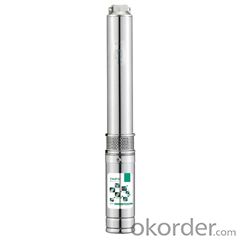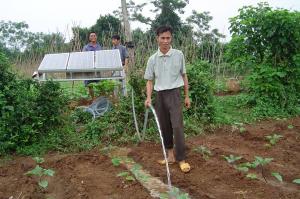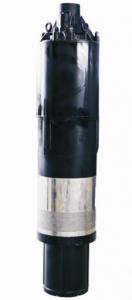Handuro Solar Pump 3tsc/4tsc Stainless Steel CE Solar Panel
- Loading Port:
- Shanghai
- Payment Terms:
- TT OR LC
- Min Order Qty:
- 50 pc
- Supply Capability:
- 100000 pc/month
OKorder Service Pledge
OKorder Financial Service
You Might Also Like
1.APPLICATION AREA:This project products are mainly used in dry region for irrigation of agriculture, It can be used for drinking water and
living water. The living condition could be much improved. It also can be used for fountains.2.MATERIAL OF PARTS:Outlet: stainless steel
Pump body: stainless steel
Motor body: stainless steel
Bearing: C&U
3.ADVANCED TECHNOLOGY:1.Application innovation
Compared with the traditional alternating current machine, the efficiency is improved 25% by the permanent magnetism, direct current, brushless, non-sensor motor.
2.Technics innovation
Adopt double plastic package for rotor and stator, motor insulation≥300MΩ, the motor security was much improved.
3.Structure innovation
Oil filling, convenient installation and environmental protection4.HIGHLIGHTSa.Energy-saving and environment-protected green products
b.High technique products adopting MPPT and DSP chip technique.
c.100% copper wire, cold-rolled silicon steel sheet
d.CE certificate
e.Advanced three phase brushless DC motor
f.Stainless steel 316 screws
g.3 years warranty5.PRINCIPLE OF OPERATION:Solar panel collects sunlight→DC electricity energy → solar controller(rectification,stabilization,amplification,filtering)→available DC electricity→(charge the batteries)→pumping water6.ADVANTAGES OF SOLAR PUMP SYSTEM:A.It is easier and more widely used than any other dynamoelectric driven pumps.
B.It is more economical and more environmentally friendly.7.MODEL SELECTION:a.The power of solar panel = power of pump ×1.3
The voltage of solar panel = the voltage of pump
The controller should be matched
b.Select the batteries according to the following formulas:
The use hour of battery =
The battery capacity ÷(the machine power÷the battery voltage)×0.6 For example,the machine power is 200W, the battery
capacity is 100AH,the voltage is 12V,and the battery is fully charged,then the use hour is:100÷(200÷12)×0.6=3.6hours
c.The battery capacity=
the use hour ÷0.6×(the machine power÷the battery voltage) For example,the machine power is 200W,the battery voltage
is 12V,and the battery need to be used for 3.6hours,then the battery capacity is:3.6÷0.6×(200÷12)=100AH


- Q: Can a solar pump be used for water supply in electronics or semiconductor manufacturing?
- No, a solar pump cannot be used for water supply in electronics or semiconductor manufacturing. These industries require a high level of purity and precision in their water supply, which can only be achieved through specialized filtration and treatment systems. Solar pumps are typically used for agricultural or domestic water supply purposes, where the water quality requirements are not as stringent.
- Q: Can a solar pump be used in residential buildings?
- Yes, a solar pump can be used in residential buildings. Solar pumps are a sustainable and cost-effective option for drawing water from wells or other sources, making them suitable for residential use. They can provide water for a variety of applications such as irrigation, domestic use, and pool circulation, helping to reduce electricity costs and environmental impact.
- Q: How much sunlight is required for a solar pump to operate effectively?
- Several factors, such as the type and capacity of the pump, the location, and the specific requirements of the application, determine the amount of sunlight necessary for a solar pump to function effectively. Generally, solar pumps are designed to operate optimally in areas with abundant sunlight. They rely on direct sunlight to produce electricity through PV panels, which powers the pump. While most solar pumps can operate with varying levels of sunlight, their efficiency and performance may be significantly reduced in low light conditions or on cloudy days. The exact amount of sunlight required can vary, but as a general guideline, a solar pump typically needs a minimum of 4 to 5 hours of direct sunlight per day to function effectively. It is worth noting that some solar pumps are equipped with battery storage systems, enabling them to operate even when sunlight is unavailable. These pumps can store excess energy generated during the day and utilize it later when sunlight is limited. This feature ensures continuous operation during low light conditions or at night. To determine the specific sunlight requirements for a solar pump, it is advisable to consult the manufacturer's specifications or seek professional advice from a solar pump installer or supplier. They can provide more precise information based on the specific pump model and application requirements.
- Q: Can a solar pump be used for irrigation in greenhouses?
- Yes, a solar pump can be used for irrigation in greenhouses. Solar pumps are a sustainable and cost-effective solution for greenhouse irrigation as they utilize solar energy to power the pump, eliminating the need for electricity or fuel. This makes them suitable for remote locations or areas with limited access to electricity. Additionally, solar pumps can be easily integrated into existing irrigation systems, providing a reliable and environmentally friendly method to deliver water to greenhouse crops.
- Q: How does the type of soil affect the installation of a solar pump?
- The type of soil can have a significant impact on the installation of a solar pump. Different soil types have varying levels of permeability, which affects how water is absorbed and drained. In sandy or loose soils, the water may drain quickly, potentially leading to instability and sinking of the pump system. On the other hand, clay or compacted soils can result in poor drainage, potentially causing water to accumulate around the pump system and adversely affecting its performance. Therefore, selecting the appropriate installation technique and ensuring proper soil preparation is crucial for the successful installation and long-term operation of a solar pump.
- Q: What is the required maintenance schedule for a solar pump?
- The required maintenance schedule for a solar pump typically includes regular inspection and cleaning of the solar panels to ensure optimal sunlight absorption, checking and tightening of electrical connections and wires, monitoring and cleaning of the pump filter to prevent clogging, and periodic inspection of the pump motor and bearings for any signs of wear or damage. Additionally, it is important to regularly monitor the water level and pressure to ensure efficient operation.
- Q: How does a solar pump handle water with high levels of turbidity or suspended solids?
- A solar pump is typically not designed to handle water with high levels of turbidity or suspended solids. These pumps are more suitable for clean water sources as the presence of turbidity or suspended solids can clog the pump, reducing its efficiency and potentially causing damage. In such cases, pre-treatment methods like settling tanks or filters may be required to remove the solids before the water is pumped.
- Q: How does the distance between the solar panel and the pump affect the performance of a solar pump?
- The distance between the solar panel and the pump can affect the performance of a solar pump in several ways. Firstly, the longer the distance, the more resistance the electricity has to overcome, resulting in potential power loss and reduced efficiency. Secondly, a longer distance may require the use of larger wire gauges to minimize voltage drop, which can increase installation costs. Additionally, the longer the distance, the higher the chances of shading or obstructions, which can decrease the amount of sunlight reaching the solar panel and further impact pump performance. Therefore, minimizing the distance between the solar panel and pump is crucial for optimizing the performance of a solar pump.
- Q: Can a solar pump be used for water supply in vineyards or orchards?
- Water supply in vineyards or orchards can be facilitated by the use of solar pumps. These pumps are a sustainable and efficient method of extracting and distributing water from sources such as wells, ponds, or rivers. By converting solar energy into electricity to power the pump, solar pumps eliminate the need for grid electricity or diesel generators. In the agricultural settings of vineyards or orchards, water is vital for the growth and health of plants, especially during dry seasons or when irrigation is required. Solar pumps present a reliable and environmentally friendly solution for water supply in these settings. The utilization of solar pumps in vineyards or orchards offers several benefits. Firstly, they are cost-effective as they do not require ongoing fuel costs or electricity bills. Once installed, solar pumps have minimal maintenance requirements, leading to reduced operational expenses. Additionally, solar pumps have a long lifespan, providing a long-term water supply solution. Furthermore, solar pumps contribute to sustainable agricultural practices by being environmentally friendly. They do not produce any pollution or greenhouse gas emissions during operation, thereby reducing reliance on fossil fuels and promoting the use of renewable energy. Moreover, solar pumps can be customized to meet the specific water requirements of vineyards or orchards. The choice between submersible or surface pumps can be based on the depth of the water source and the desired water flow rate. Furthermore, solar pumps can be equipped with sensors and automation systems to optimize water usage, ensuring efficient irrigation and water conservation. Overall, solar pumps are a viable and advantageous option for water supply in vineyards or orchards. They offer a sustainable, cost-effective, and environmentally friendly solution, ensuring the continuous growth and productivity of plants while reducing dependence on non-renewable energy sources.
- Q: Are solar pumps suitable for use in amusement parks?
- Yes, solar pumps are suitable for use in amusement parks. They are cost-effective, environmentally friendly, and can provide a reliable source of water for various attractions such as water rides, fountains, and decorative features. Additionally, solar pumps require minimal maintenance and can be easily integrated into existing infrastructure, making them a practical choice for amusement parks seeking sustainable and efficient water management solutions.
Send your message to us
Handuro Solar Pump 3tsc/4tsc Stainless Steel CE Solar Panel
- Loading Port:
- Shanghai
- Payment Terms:
- TT OR LC
- Min Order Qty:
- 50 pc
- Supply Capability:
- 100000 pc/month
OKorder Service Pledge
OKorder Financial Service
Similar products
Hot products
Hot Searches
Related keywords



















